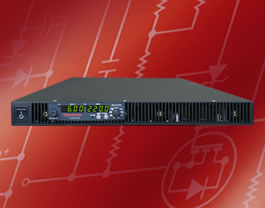The most important thing that a power supply does is to maintain a constant voltage output or a constant current output. This is true whether the power supply is built into a product and provides fixed output voltages, such as a desktop computer power supply, or a power supply that is on the test bench or is part of an automated test system that must provide variable outputs. We call this ability to maintain a constant output voltage or current regulation.

The Sorensen XG 1500 Series is an industry leading programmable DC power supply designed for test, production, laboratory,OEM and quality assurance applications. The XG 1500 is a 1500 Watt, 1U programmable power supply with constant voltage and constant current modes, automatic cross-over and numerous features enabling cost effective,easy integration.
Load regulation
There are actually two types of regulation that you need to be aware of when selecting a power supply: load regulation and line regulation. Load regulation is the ability of a power supply to maintain a constant output voltage (or current) under under very light loads and under loads near the maximum current. That is to say that if you set the output voltage of a supply to say 10 VDC, the supply should be able to maintain its output at 10 VDC when no current is being drawn from the supply and when the maximum current is being drawn from the supply.
To see how this might work in practice, let's take a look at the Sorensen XG 12.5-120, one of the supplies in the XG 1500 Series. It can supply up to 12.5 VDC at currents up to 120 A. The load regulation for the XG 1500 Series is specified to be 0.005% of rated output voltage + 2 mV. For a 10 V output, that works out to be 2.5 mV, from no load to 120 A.
Line regulation
The calculations for load regulation assumes that the AC input voltage will remain constant. Of course, this is not always the case. AC line voltage can change, and this can also affect the output of a power supply. The ability of a power supply to maintain a constant output voltage when the input voltage changes is called line regulation.
The line regulation for the XG 1500 Series is also 0.005% of rated output voltage + 2 mV, assuming a constant load. For a 10 V output, that works out to be 2.5 mV, with an input voltage of 85-132 VAC for the nominally 110 VAC model, or an input voltage of 170-265 VAC for the nominally 220 VAC model.
Load and line regulation aren't the only specifications that affect a power supply's output. In some applications, for example, transient response time is also important. Load and line regulation are baseline specifications, though. Without good line and load regulation, the other specifications are meaningless.
For more information on DC power supplies, and how to use them in your application, contact AMETEK Programmable Power. You can send an e-mail to sales.ppd@ametek.com or phone 800-733-5427.
